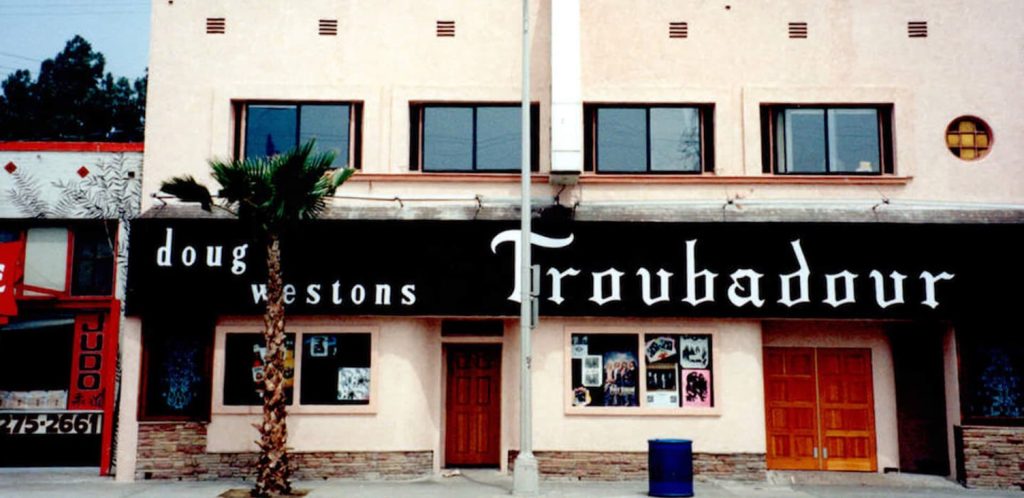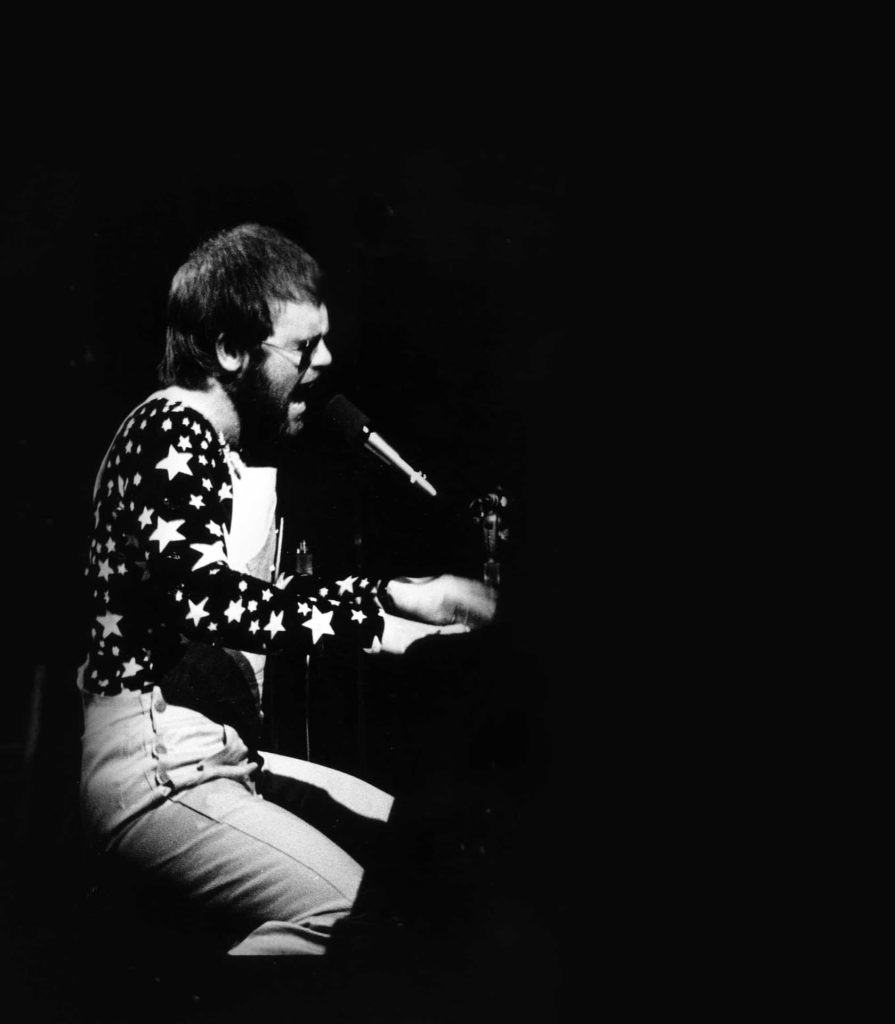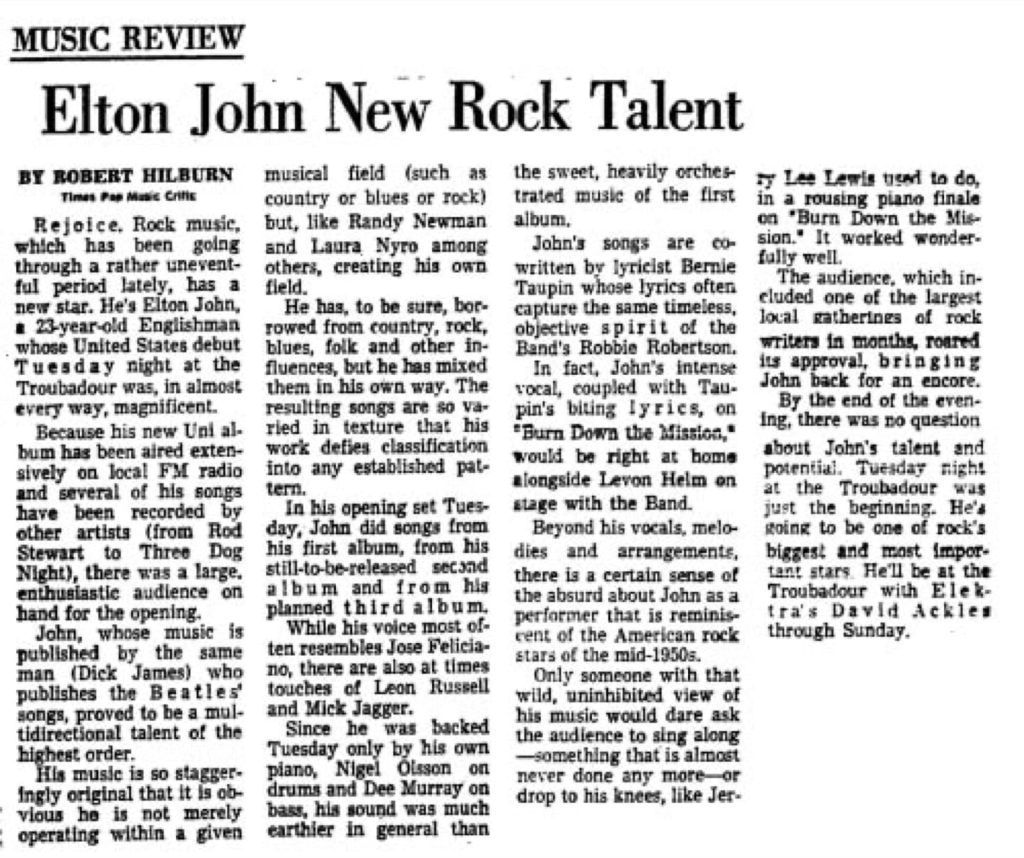Menu
Elton’s First Shows in the U.S. – A Look Back
Elton made his American debut at Doug Weston’s Troubadour nightclub on the night of August 25, 1970…and almost immediately after he, drummer Nigel Olsson, and bassist Dee Murray left the stage at 9081 Santa Monica Boulevard in West Hollywood, the aftershocks of their seismic recital began to roll across the landscape of not only his own career but also popular music worldwide.

“It was magical, that night. August 25, 1970 is considered one of the ten greatest nights in Rock & Roll history.”
– Russ Regan (President of Uni Records, Elton’s label in America)
Elton, Nigel and Dee, along with lyricist Bernie Taupin and four members of Elton’s Dick James Music (DJM) team arrived in Los Angeles on August 21st. There at LAX to greet them was a red double-decker ‘London’ bus with a huge banner on the side reading “Elton John has arrived.” Until this moment the contingent from London were utterly unaware of what they were about to be swept up in. As they posed in front of the bus for photographs, Elton and the group began to get a sense of the level of hype that had been permeating through southern California over the previous couple of months.
Elton’s American debut may have cost $5 to get in, but very few people in the audience that evening had been asked to pay the cover charge. US label reps and publicists Norm Winter, David Rosner and Russ Regan had spent the better part of the previous two months assuring that the 300-seat club would be filled with celebrities and notables from the LA music and media communities. Some were there to see this new piano player they had been listening to on their radios and turntables, some were there at the behest of the Uni team, and some were there simply because the Troubadour was the place to be if you wanted to hear good music in LA and be a part of the scene. Spotted in the audience were the likes of Quincy Jones, The Beach Boys’ Mike Love, Gordon Lightfoot, and Danny Hutton – who, as a member of Three Dog Night, had already released two John/Taupin compositions, Lady Samantha and Your Song, in the past 14 months.
Neil Diamond, holder of the Troubadour house record for attendance at the time, introduced Elton to the crowd, and then the show began.

“The audience was expecting James Taylor…and they got a cross between Jerry Lee Lewis and Leonard Cohen. Someone with great depth and also great entertainment flair. They were certainly not expecting what they ultimately experienced, myself included.”
– David Rosner (Music Manager of DJM in the United States)
I will always remember the first show…especially because of the way the audience reacted to a band of three sounding almost like the recordings on the Elton John album.
The set list included: Your Song, Bad Side Of The Moon, Sixty Years On, I Need You To Turn To, Border Song, Country Comfort, Take Me To The Pilot, Honky Tonk Woman and Burn Down the Mission (which featured a medley of My Baby Left Me and Get Back as the song slammed past the ten-minute mark). Of these songs, just five were on the only Elton John record actually available for sale in the United States at the time. One song was a Rolling Stones cover, one was the b-side to his Border Song single…and two were from an album that would not reach American ears for another five months.
Following the Tuesday night debut, Elton played one show each evening on Wednesday and Thursday, then two shows (at 8 and 10 PM) on Friday and Saturday, and finally one on Sunday night to wrap up the stand.
Back in 1970 it couldn’t help but take a few days for a buzz to spread, even in a local area. But once the newspapers had been delivered to doorsteps and newsstands across Southern California, it became clear that the reviews of his Tuesday night show had been written by ecstatic scribes.
None more so than Robert Hilburn, whose assessment appeared on page 22 of the LA Times two days after the show, on the morning of August 27.

“These guys were taking me somewhere else…I was seeing something I hadn’t seen come along in a while. This was very exciting – this was very different. He had so much going for him: he could be a winning act in person, it could be something you could sit down with in a crowd and listen to, and you could sit down in your room and listen to it on your own. It seemed to me that if you had a check-list of what things you thought were good in music, and a check-list of what things were commercial…they connected on both scales. And that was rare.”
– Robert Hilburn
Hilburn’s review, like no other alongside it, would generate a great deal of interest amongst the readership of the LA Times (which was nearly 900,000 strong at the time), the not-easily-impressed movers and shakers of the LA music industry, everyone inside Elton’s entourage…and the public at large. While the singer certainly had the talent to ascend the music business at some point, Hilburn’s ink-wash of praise unarguably lit the match to the fuse on Elton’s career.
So, as the jet took off for London in early September, it carried homeward eight people changed by the experience of the last two weeks. Some would eventually settle in Southern California, some would work for Elton long enough to see every fantastic stage of his career, and some would continue their careers elsewhere in the industry. Sadly, Dee Murray would be taken too soon, in 1992, at the age of 45.
And at the axis of this group: a 23-year-old pianist and songwriter still legally named Reg Dwight. Who, to his great surprise, had discovered the road to stardom somehow led from Santa Monica Boulevard. The transition to truly becoming Elton John had begun.
'Elton' would have happened anyway. But it wouldn’t have taken off like a rocket, as it did, without that performance and that band.
